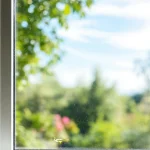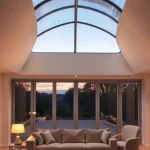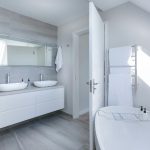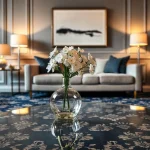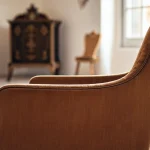Modern Innovations Shaping British Living Spaces
British living space trends are evolving rapidly, blending modern technology with classic aesthetics to redefine home design innovations. Today’s UK homeowners seek to maintain the timeless charm of their houses while integrating contemporary design updates that enhance comfort and functionality.
Technology plays a crucial role in this transformation. For example, smart heating systems and automated lighting are being incorporated into traditionally styled interiors without disrupting their balance. These upgrades not only improve energy efficiency but also offer intuitive control, aligning with sustainable living goals.
Also read : Top-rated eco-friendly window cleaners in chilworth for streak-free shine
Moreover, sustainability extends beyond technology. The use of eco-friendly materials and energy-efficient solutions is becoming a key feature in British living space trends. Homeowners are adopting sustainable home design innovations such as reclaimed wood or low-impact paints, which respect the heritage of their homes while contributing to environmental stewardship.
Blending these innovations demands creativity. Designers merge sleek modern elements with distinctive British architectural details—like crown moldings or sash windows—achieving a harmonious coexistence between past and present. This fusion exemplifies how contemporary design updates can respect tradition, meeting modern expectations without sacrificing character.
Also to read : Expert window cleaning in chilworth for streak-free, eco-friendly results
Smart Technology Enhancements for Traditional Homes
Integrating smart home technology into historic British homes, such as Victorian or Georgian properties, requires a delicate balance. Homeowners seek smart upgrades for historic homes that preserve architectural features while enhancing convenience. For example, installing smart lighting and thermostats with wireless systems avoids intrusive wiring, safeguarding period details like ornate cornices or decorative plasterwork.
Security systems tailored for traditional spaces offer discreet monitoring without compromising aesthetics. These solutions often use minimal fixtures and integrate seamlessly with existing décor. The goal is to blend modern convenience with historical authenticity, ensuring that lifestyle improvements do not detract from a home’s character.
Preserving authenticity means using installation methods that are reversible and non-invasive. Wireless controls, battery-powered sensors, and smart hubs placed strategically help maintain the integrity of walls and ceilings. This approach respects the craftsmanship of older interiors while delivering tangible benefits like remote climate control or automated lighting schedules.
Ultimately, successfully integrating smart home technology in historic homes demands thoughtful choices. Selecting technology that can be tailored to traditional layouts and finishes ensures improvements are both elegant and practical. This synergy between past and present exemplifies cutting-edge home design innovations within British living space trends.
Space-Saving Solutions for Compact British Houses
In many British homes, limited space poses a significant challenge, especially in older properties with smaller rooms. Space-saving solutions address this by optimizing every inch, creating more functional living areas without extensive remodeling. Multifunctional furniture is a cornerstone of this trend. For example, sofa beds, fold-away tables, and storage ottomans combine utility and style, allowing rooms to serve multiple purposes seamlessly.
Efficient layouts for older homes emphasize built-in storage, such as under-stair cupboards or window seats with hidden compartments. These clever designs reduce clutter, improving the sense of openness. Open-plan concepts, when feasible, enhance airflow and natural light. Thoughtful zoning using furniture placement and partial dividers creates distinct areas without compromising the integrity of traditional floorplans.
How do these strategies impact British living space trends? They enable homeowners to modernize interiors while respecting original architecture. Integrating these space-saving elements complements contemporary design updates by marrying practicality with aesthetic appeal. Ultimately, using multifunctional furniture and efficient layouts transforms compact spaces into inviting, adaptable homes that reflect current preferences without erasing heritage character.
Sustainable Materials and Practices in Heritage Properties
Balancing eco-friendly renovations with preserving the charm of heritage properties requires mindful use of sustainable home materials. Retrofitting period homes often focuses on improving energy efficiency without altering character. For example, upgrading insulation with breathable natural materials reduces heat loss while protecting historic fabrics. Secondary glazing or smart double-glazed windows maintain original sash window profiles but significantly enhance thermal performance.
Energy-efficient heating solutions, such as retrofit heat pumps or smart thermostats, can be integrated sensitively to respect interiors. These sustainable upgrades reduce fuel consumption and carbon footprints while meeting modern comfort standards. Choosing low-impact paints and reclaimed timber for repairs further supports environmentally responsible restoration.
Such eco-friendly renovations prove that sustainability and heritage preservation can go hand-in-hand. Carefully specified materials and techniques ensure that improvements are reversible and compatible with older structures. This approach reflects current British living space trends that demand both environmental responsibility and an enduring connection to architectural history, exemplifying thoughtful home design innovations in action.
Modern Innovations Shaping British Living Spaces
Modern home design innovations are shaping British living spaces by blending contemporary design updates with traditional elements. These trends reflect a desire to preserve historic charm while enhancing functionality and comfort. One key driver is the integration of technology—homes now feature smart controls and energy-efficient appliances that improve daily living without overwhelming classic architectural details.
Sustainability also plays a vital role. The adoption of eco-conscious materials and methods—such as reclaimed timber and energy-saving systems—aligns with growing environmental awareness. These elements not only reduce environmental impact but also enhance heritage homes’ longevity.
The challenge lies in harmonizing modern innovations with distinctive British features like sash windows, moldings, and fireplaces. Designers achieve this by carefully selecting and positioning updates to complement, not compete with, the original structures. For instance, incorporating unobtrusive smart lighting or eco-friendly insulation preserves visual authenticity while upgrading performance.
In essence, British living space trends prioritize balance: retaining historical identity while embracing smart technologies and sustainable practices. This approach allows homeowners to enjoy timeless beauty alongside innovative comforts that reflect 21st-century living demands.
Smart Technology Enhancements for Traditional Homes
Smart home technology is increasingly vital in British living space trends, especially for homeowners seeking smart upgrades for historic homes. Integrating smart lighting, thermostats, and security systems into Victorian or Georgian homes enhances comfort without compromising period charm. Wireless and minimally invasive installation methods stand out as essential techniques. For instance, battery-powered sensors and discreet smart hubs minimize damage to delicate plasterwork or wood moldings.
How does one preserve architectural details while integrating tech? The key lies in choosing equipment that complements existing aesthetics and using reversible fixes. Wireless controls avoid unsightly wiring. Smart thermostats can connect to radiators without altering original valves. Security solutions utilize small cameras and motion sensors that blend invisibly into traditional interiors.
Balancing modern convenience with historical authenticity requires thoughtful planning. Designers prioritize seamless integration so that technology serves occupants effectively without overshadowing classic architectural features. This synergy—combining home design innovations with time-honoured styles—epitomizes current British living space trends. Homeowners enjoy enhanced functionality and security while maintaining the unique character that defines heritage homes, proving that integrating tech in traditional spaces is both practical and sophisticated.




